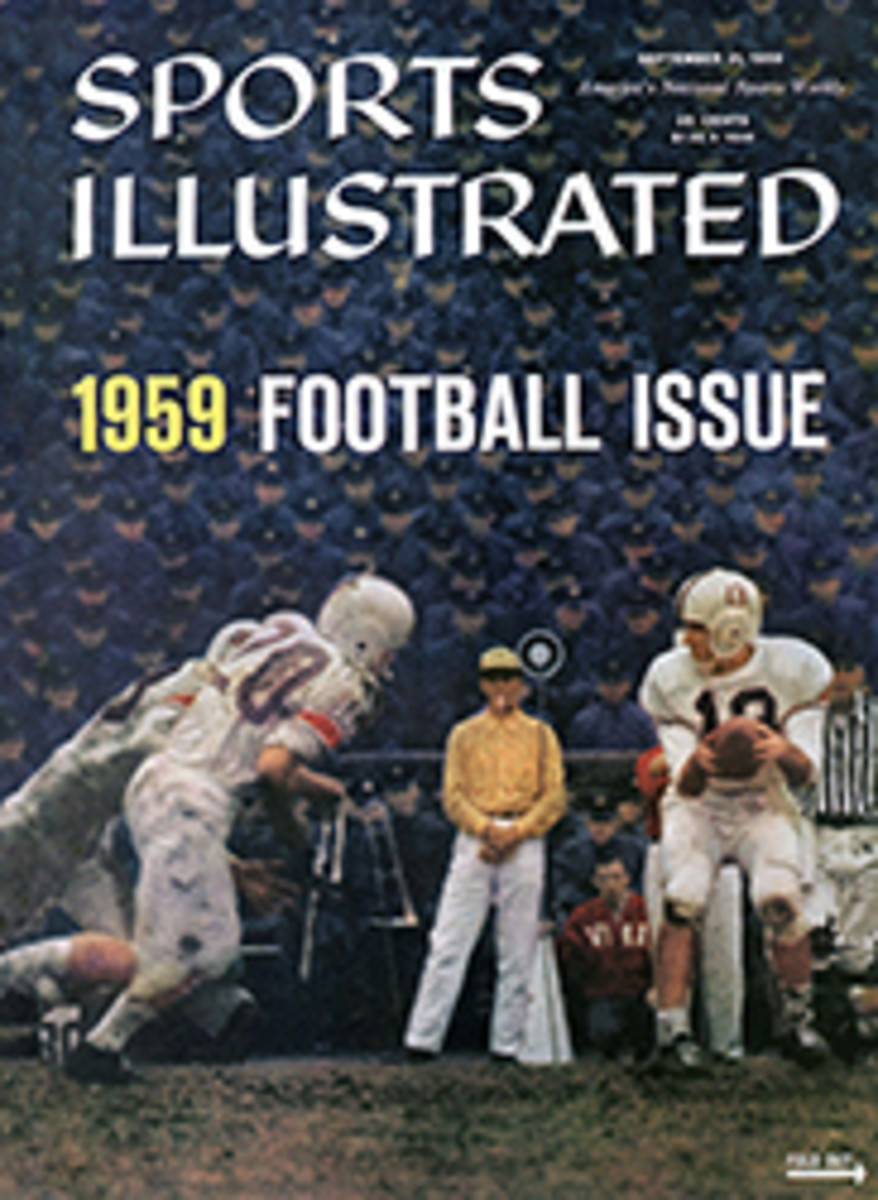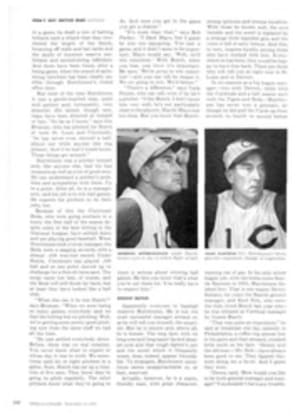
College for caddies
On Nantucket Island, squatting in the scrub oak between the 11th and 13th fairways of the exclusive and well-groomed Sankaty Head Golf Club with a sort of cockeyed but cheerful unconcern, is Camp Sankaty, a summer camp for caddies. Last week the camp closed out another extremely successful season. Once again it not only relieved the local caddie shortage, but it also served as a superb example to the rest of the golfing nation, harried as it is by a severe and growing shortage of experienced caddies.
This miniature village consists of five tiny, homemade wooden bunk-houses, a canvas tent, one low, sprawling main building and a rudimentary outbuilding housing showers and toilets. It is invaded every summer by four dozen boys 14 to 18 years old. They come to Nantucket, 30 miles off the coast of Massachusetts, from as far away as Birmingham, Ala., Lakeland, Fla. and Chicago to learn to caddie, make money and have a whale of a time.
The man behind this annual migration of eligible and willing caddies is Camp Sankaty's director and founder, Donald Morison Smith. He is a hefty, hopelessly generous, good-humored and gregarious man of 65 with bristling white hair, top-rim glasses and a gravelly voice that pops back and forth indecisively from a faint Scottish brogue (he spent 11 years of his early boyhood in Scotland) to a strong central Massachusetts accent (he was born in Worcester and lived there most of his life). Smith has run caddie camps for 35 years. He founded his first one at Hyannisport on Cape Cod back in 1921 and stayed with it until 1953. He set up the Sankaty Head camp in 1930 at the request of local club members who were anxious to create a steady fund of caddies on their lightly populated island. His Sankaty Head camp is so successful that, despite the fact that all of Smith's advertising is strictly word-of-mouth, generated by most of the 900 boys who have attended over the past 30 years (and are now busy sending back their sons and nephews and their friends' sons and nephews), he must turn down some 200 applications for admission each season.
Smith is guided by a simple but universally accepted principle. In exchange for services—i.e., caddying at Sankaty Head Golf Club—the boys receive a steady income. They have an enjoyable summer besides. Each camper pays an admission fee of $25 plus $16.50 a week for board and room. This is all he pays. The caddie assignments are handed out on a rotating, alphabetical basis at 9 o'clock each morning, but eager youngsters who want to squeeze in a few extra rounds of work (known, but not unkindly, as shekel-grabbers) are permitted to gallop up to the clubhouse an hour or so before 9 a.m. to caddie for early-bird golfers. A caddie is paid a fee of $4 for carrying two bags 18 holes, plus a bonus of $1 for each such round provided he stays right through until Labor Day. Most do. Sankaty Head members are notoriously good tippers and with fees and tips combined a camper of average industry can clear between $100 and $150 over and above board, room and expenses for the nine-week term. Some zealous shekel-grabbers have earned as much as $300 in a single summer.
"I guess there are three main reasons why boys come to a camp like this," Smith said the other day. "Some come because they want to earn money over the summer and have an enjoyable vacation. Others come for the vacation alone. I guess the rest of them are here because their parents wanted to get rid of them for a couple of months."
"I think you forgot the most important reason," chimed in 20-year-old Bill Binney, the camp's assistant director, who started caddie camping under Smith back in 1953. "The guys get to play this course," said Binney, who comes from Wrentham, Mass., and will be a junior this year at the University of Massachusetts where he majors in mathematics. He and many of the caddies play Sankaty Head's excellent 6,551-yard, par-72 course at least four or five times a week, free of charge.
Several weeks prior to his arrival on Nantucket each prospective camper is mailed material outlining the science of caddying. Once camp gets under way, the first-year men (there were 23 this year, half of whom had caddied before and a third of whom had played golf) are given on-the-job training. On the first of these days, tutored by Binney, his assistant Colin MacCleod and Caddie Master Wilfred Bowler, the newcomers are given a thorough indoctrination in their duties on and around the putting green, i.e., where to stand, how and when to move, how and when to hold the flagstick, etc. MacCleod is a stocky youngster of 18, also from Wrentham, and is just starting his sophomore year at the University of Kentucky. Bowler is 19 and a distance runner from New Bedford, Mass. He prefers running over the course to playing on it and has won the camp "marathon" championship (3½ miles) two years in a row. All were longtime Camp Sankaty caddies and know their jobs well.
TIP FROM THE TOP
On the second day Binney and MacCleod go out with groups of four to six boys and play the course, explaining to each group the functions of a caddie from tee to green. The most important item is for the caddie to keep his eye on the ball after it has been hit, often wildly. The secret is to line the ball up with two stationary objects, not one, thus giving double insurance that the ball will not be lost.
Once the indoctrination period is over, camp gets under way in earnest. The boys are routed out of bed at 7 every morning to dress and pass dorm inspection. After breakfast the first group of caddies is sent up to the clubhouse. From time to time, as more golfers pile out onto the 18 windswept holes, Caddie Master Bowler will call back to camp for reinforcements, until finally the camping area is entirely cleared of caddies. On days when the weather is not favorable for golf, some of the boys will not get out on the course at all. They stay at the camp, taking part in the camp's varied sports program.
After supper most of the camp's organized activities take the stage. During the early evening, league games in such team sports as soccer, touch football and volleyball are played. On Thursday and Sunday nights campfire meetings are held which all the boys attend, and on Saturday night everyone piles into the town of Nantucket, eight miles distant, for the late night of the week. Otherwise it's bed at 10 p.m.
It takes a man like Smith, a former Worcester YMCA, Boy Scout troop and church group leader, to maintain the warm, homey atmosphere that prevails at Camp Sankaty. He puts a good deal more into his camp than he takes out of it. Institutions of this type, and there are probably fewer than a dozen in the country, can and do yield substantial revenues to less altruistic directors. Smith admitted as his season ended that his profits were not high. He operates on a revenue of $9,300: $1,500 paid outright by the Sankaty Head club, $6,700 coming from the campers for their board and room, and $1,125 from the admission fees. Smiddy's overhead for salaries is $1,500: $400 to Binney, $300 to Bowler, $200 to MacCleod, who also caddies in the afternoons, and $600 to the cook, a young Korean named Sang Chu Suh who will start studying at Harvard this fall for his Ph.D. in economics. Other expenses, for food, utilities, freight, uniforms, maintenance, improvements, etc., amount to over $6,600. This leaves Smith something under $1,200, which is not a total that will have him clipping stock coupons when he retires.
But profit is not Smith's motive. He believes that a widespread increase in camps such as Camp Sankaty would fill a serious social and economic need for many of the teen-age boys in this country. Initially, these camps create an active and interesting form of activity for boys during the restless and potentially troublesome summer months. Not only can the campers experience the great satisfaction of being self-supporting for a few weeks, they also reap a nice profit all their own. And who's going to kick about the by-product? For the golf clubs lucky enough to be partnered with a caddie camp, there is an unlimited flow of skillful, experienced and—perish the thought—contented caddies.
PHOTO
POISED FOR ROUND with Pros Ernie Boros, George Bayer, Julius Boros and Jay Hebert are Caddies Colin MacCleod (left), John Downey, Joe Morrison and John Dowd.

